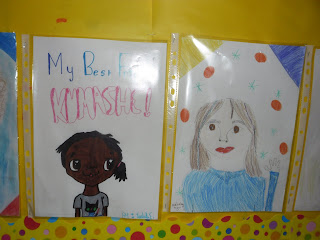 |

We drew pie charts in order to demonstrate our choice of food colouring. We discussed it first. We spoke about Probability.What were the odds of any one of the four colours, red, blue, green or yellow being chosen? We decided that that the odds were one in four. After that it was a matter of personal preference. We voted. Eleven pupils chose blue, eight chose green, four chose red and one chose yellow. There are 360 degrees at the centre of a circle.The blue section worked out as 165 degrees, an obtuse angle. The green section worked out 120 degrees, another obtuse angle. The red section was 60 degrees, an acute angle and the yellow "piece of pie" had a tiny angle of 15 degrees! Of course we added them all up to verify that they amounted to 360 degrees. They did.A pie chart is useful because it conveys information at a glance. There is no language barrier with a pie chart!
For our experiment we used water, cooking oil, a clear plastic lemonade bottle, food colouring and a piece of an Alka Seltzer tablet. We poured the water into the bottle until it was one quarter full. We used a jug to pour. We could also have used a funnel. There was some discussion about what would happen when we poured in the oil. What would be the outcome? Would it remain on top? Would it sink to the bottom? Would it blend with the oil.? There were three possibilities. The water remained at the bottom and the oil stayed on top. We then added the blue food colouring, ten drops of it. What would happen ? We discussed this. The blue liquid sank down through the oil and blended with the water below. We then broke up an Alka Seltzer tablet and dropped a small piece into the bottle. After a few seconds, blue bubbles rose up from the water, through the oil and burst at the surface, releasing the blue water which sank to the bottom again. This was repeated again and again. It was quite dynamic and the photograph does not do it justice. :)
So, we know what happened here, but why and how? The water remained at the bottom because it has greater density than the oil. This means that it is heavier than oil, even though there is less of it! A tiny steel ball is heavier than a large beach ball. It has greater density. Have you ever heard the expression "Oil and water do not mix", when people talk about things or people that do not agree with each other? The food colouring, being water-based, blended with the water. The Alka Seltzer which we dropped in released carbon dioxide gas which rose to the surface taking with it some of the coloured water. The gas escaped when the bubbles reached the top, releasing the coloured water which flowed back down. Then this dynamic repeated itself! Alka Seltzer forms carbon dioxide gas when dissolved in water because it contains citric acid and sodium bicarbonate(baking soda to you and me). When the effect of the Alka Seltzer weakens, we can always add more, to repeat the experiment. :) Great fun!



















 elf
elf





























